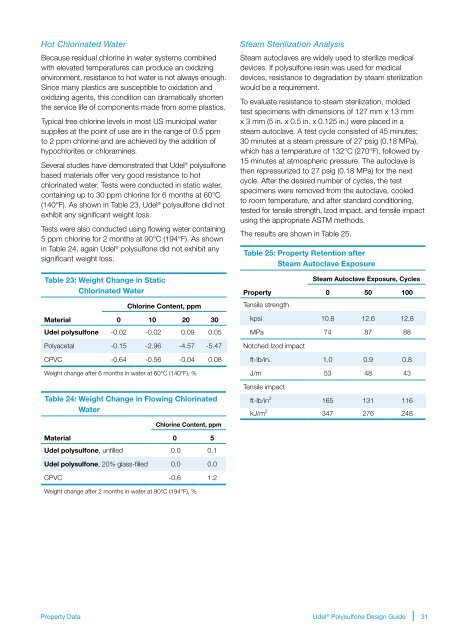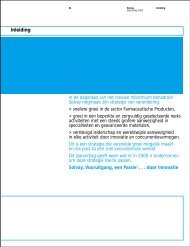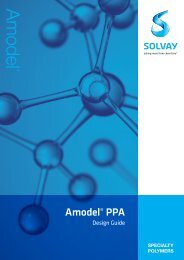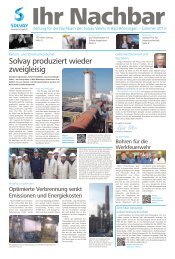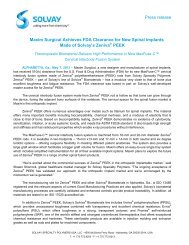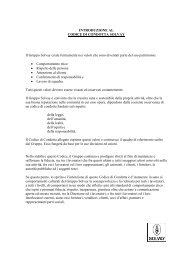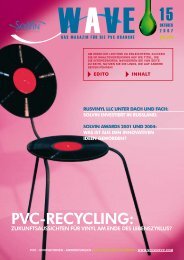Design Guide - Solvay Plastics
Design Guide - Solvay Plastics
Design Guide - Solvay Plastics
You also want an ePaper? Increase the reach of your titles
YUMPU automatically turns print PDFs into web optimized ePapers that Google loves.
Hot Chlorinated Water<br />
Because residual chlorine in water systems combined<br />
with elevated temperatures can produce an oxidizing<br />
environment, resistance to hot water is not always enough.<br />
Since many plastics are susceptible to oxidation and<br />
oxidizing agents, this condition can dramatically shorten<br />
the service life of components made from some plastics.<br />
Typical free chlorine levels in most US municipal water<br />
supplies at the point of use are in the range of 0.5 ppm<br />
to 2 ppm chlorine and are achieved by the addition of<br />
hypochlorites or chloramines.<br />
Several studies have demonstrated that Udel ® polysulfone<br />
based materials offer very good resistance to hot<br />
chlorinated water. Tests were conducted in static water,<br />
containing up to 30 ppm chlorine for 6 months at 60°C<br />
(140°F). As shown in Table 23, Udel ® polysulfone did not<br />
exhibit any significant weight loss.<br />
Tests were also conducted using flowing water containing<br />
5 ppm chlorine for 2 months at 90°C (194°F). As shown<br />
in Table 24, again Udel ® polysulfone did not exhibit any<br />
significant weight loss.<br />
Table 23: Weight Change in Static<br />
Chlorinated Water<br />
Chlorine Content, ppm<br />
Material 0 10 20 30<br />
Udel polysulfone -0.02 -0.02 0.09 0.05<br />
Polyacetal -0.15 -2.96 -4.57 -5.47<br />
CPVC -0.64 -0.56 -0.04 0.08<br />
Weight change after 6 months in water at 60°C (140°F), %<br />
Table 24: Weight Change in Flowing Chlorinated<br />
Water<br />
Chlorine Content, ppm<br />
Steam Sterilization Analysis<br />
Steam autoclaves are widely used to sterilize medical<br />
devices. If polysulfone resin was used for medical<br />
devices, resistance to degradation by steam sterilization<br />
would be a requirement.<br />
To evaluate resistance to steam sterilization, molded<br />
test specimens with dimensions of 127 mm x 13 mm<br />
x 3 mm (5 in. x 0.5 in. x 0.125 in.) were placed in a<br />
steam autoclave. A test cycle consisted of 45 minutes;<br />
30 minutes at a steam pressure of 27 psig (0.18 MPa),<br />
which has a temperature of 132°C (270°F), followed by<br />
15 minutes at atmospheric pressure. The autoclave is<br />
then repressurized to 27 psig (0.18 MPa) for the next<br />
cycle. After the desired number of cycles, the test<br />
specimens were removed from the autoclave, cooled<br />
to room temperature, and after standard conditioning,<br />
tested for tensile strength, Izod impact, and tensile impact<br />
using the appropriate ASTM methods.<br />
The results are shown in Table 25.<br />
Table 25: Property Retention after<br />
Steam Autoclave Exposure<br />
Steam Autoclave Exposure, Cycles<br />
Property 0 50 100<br />
Tensile strength<br />
kpsi 10.8 12.6 12.8<br />
MPa 74 87 88<br />
Notched Izod impact<br />
ft-lb/in. 1.0 0.9 0.8<br />
J/m 53 48 43<br />
Tensile impact<br />
ft-lb/in 2 165 131 116<br />
kJ/m 2 347 276 248<br />
Material 0 5<br />
Udel polysulfone, unfilled 0.0 0.1<br />
Udel polysulfone, 20% glass-filled 0.0 0.0<br />
CPVC -0.6 1.2<br />
Weight change after 2 months in water at 90°C (194°F), %<br />
Property Data<br />
Udel ® Polysulfone <strong>Design</strong> <strong>Guide</strong><br />
31


